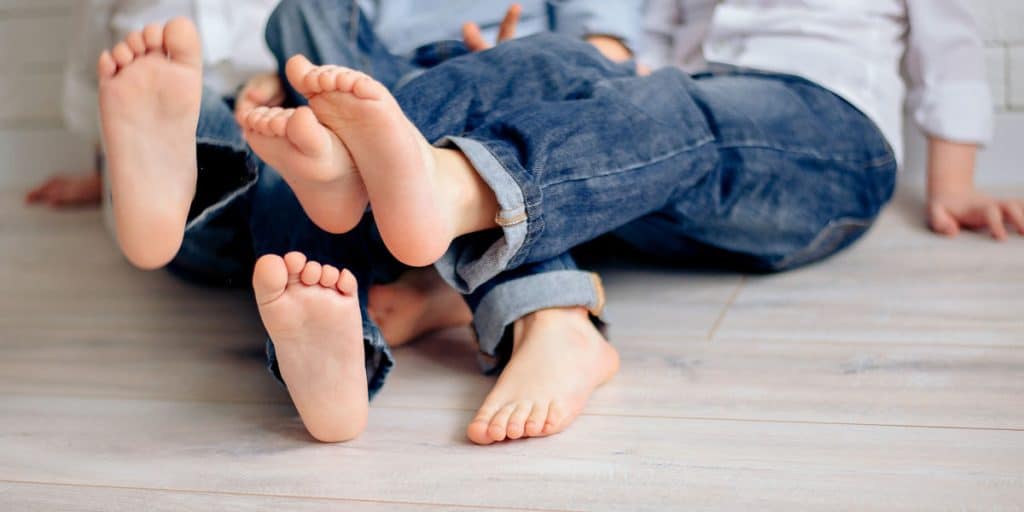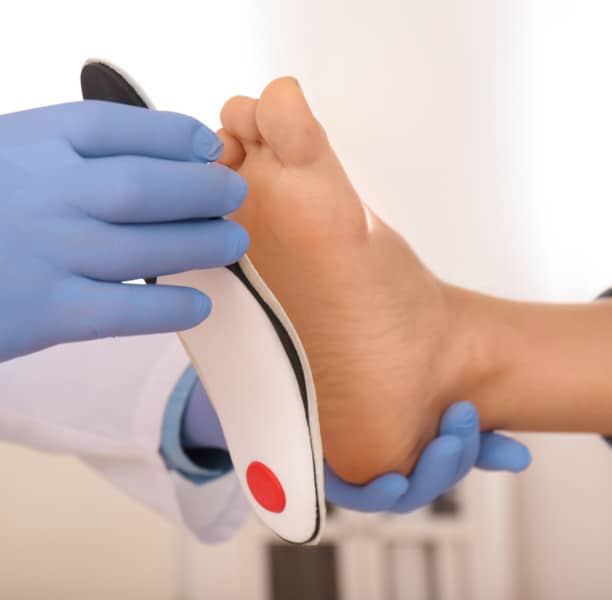I’m always honored when patients trust me with care of their children’s feet. Because children are still growing, management of pediatric flatfoot can be complex to deal with.
Personally, I find most patients will improve and stabilize with over-the-counter inserts or orthotics. Unfortunately, there is a subset who require surgical intervention for their pediatric flatfoot (fallen arches or pes planus). These are usually the patients with multiplanar deformities – which require different correction procedures depending on the child’s need.
Although there are a multitude of procedures available, through my years of experience I’ve found a few go-to options for pediatric flatfoot treatment.

Evaluating pediatric foot problems
Because our pediatric patients don’t come in alone, the “patient” is actually the child and their parent or caregiver. Usually, it’s the parent who is most concerned about the child’s foot and ankle position and (understandably) pushes harder to address the problem.
But ultimately it is the child we have to treat. When possible, I try to have the parent merely observe and stay out of the conversation so I can evaluate what the child is feeling and experiencing.
Of course, children – especially young children – don’t always have the “right” words to express the pain or discomfort they’re experiencing. That’s why my conversation with the child focuses on their activity level, what they like to do, what they can and can’t do because of their feet, and what bothers them. Can they run? Can they play sports as much as they would like? Do they have pain or just an asymptomatic flat foot or feet? In many cases, the child does not have any major pain and can exercise without much problem.
However, the child’s input cannot be the sole diagnostic factor.
Diagnosing pediatric flatfoot
After discussing the situation, it’s time for the physical exam. It’s important to examine the patient both standing and sitting for a full assessment of their condition.
While the patient stands I check:
- Position of the foot
- Level of arch collapse
- Lateral deviation of the midfoot
- Any elevation of the first metatarsal (the bone just behind the big toe)
Also while standing, I have the patient squat while I watch for any change in arch collapse or foot pronation as the ankle shifts.
During the seated examination, I assess the tightness of the calf muscle and Achilles tendon structures with the leg both straight and bent. We assess this by flexing and pointing the foot to test the range of motion.
There is more to consider than just simple mobility. One of the main missed issues that I see in pediatric flatfoot is determining flexible versus rigid forefoot varus deformity and how reducible that deformity is. It is also important to consider accessory navicular as this can also cause tendon weakness and contribute to pediatric flatfoot.
Effective imaging for pediatric flatfoot
The most important imaging for pediatric flexible flatfoot deformity is a standard weight-bearing X-ray. It may be necessary to take radiographs in both normal stance and corrected foot position to see how the foot aligns.
In such cases, a standard angle will show the regions of deformity and the amount of deformity while a corrected foot alignment will show hindfoot realignment. Realigning the hindfoot may also reveal deformities in the forefoot.
Magnetic resonance imaging (MRI) is generally more helpful in rigid flatfoot diagnosis as it allows us to see the soft tissue of the foot. However, in my experience, MRI for flexible flatfoot can have utility in a few situations, including:
- Checking for posterior tibial tendon tear or fraying.
- Checking for edema in the accessory navicular.
- Evaluating the quality of the spring ligament.
- Investigating the possibility of a fibrous coalition (if suspected).

Conservative pediatric flatfoot treatment
As noted earlier, most pediatric flatfoot cases respond well to an insole or orthotic. Proper posting of the orthotic for both forefoot and rearfoot alignment is essential to make sure the foot is properly positioned. I have found a slant board is also very helpful to stretch the calf and Achilles tendon and advise patients to stand on the slant board with both feet in shoes for about five minutes each morning.
Many patients are able to avoid surgical correction using these conservative methods.
Treating asymptomatic flatfeet
If the child has no discomfort and their feet aren’t hindering their activity level, there is no need for invasive intervention. For these patients, I recommend orthotics with proper arch alignment and supportive shoes. In addition, we’ll use Achilles tendon and calf stretching as their foundational care.
The type of orthotic I choose will range from a standard supportive device to a very deep heel cup UCBL-type device based on the needs of the patient. Usually, I recommend new orthotics with every full-size shoe change until the patient is fully grown and their growth plates are closed.
At that point, I will remake orthotics every 2–3 years based on need and amount of use. Children and adolescents are much harder on orthotics than adults and they may need new devices may be necessary earlier than adults would.
About pediatric flatfoot surgery
My go-to surgical procedure for flexible pediatric flatfoot is an Evans calcaneal osteotomy.
I find the procedure is exceptionally strong in the amount of correction it offers, it can be done at a young age as there is no growth plate in the region, and it does not increase forefoot deformity during correction.
Although subtalar implants are gaining in popularity and are easy to perform, I have found subtalar implants hard to tolerate for patients and that, in my observation, the correction of the hindfoot increases forefoot deformity. With an Evans procedure, I can correct multiple problems contributing to the flatfoot.
There are two different techniques I use for treating the forefoot depending on the cause of the hypermobility. The Evans procedure will correct some of the laxity by adding tension to the muscle that controls plantar flexion. But if that isn’t enough, I will fuse the joint causing the hypermobility.
I try to avoid the “standard” calf or Achilles tendon lengthening. Lengthening weakens the muscle/tendon in a young patient and may prevent them from returning to active, competitive sports. However, if pain or deformity persists, they may need a lengthening procedure in the future.
After surgery, it is important for the patient to complete physical therapy consisting of gait training and foot and ankle strengthening exercises. Getting the muscles and tendons back in working order will help the patient return to their full activity level.
Should flat feet be corrected?
If your child isn’t experiencing pain or discomfort from their flat feet, why bother treating it? As I’ve discussed here, pediatric flatfoot can be indicative of a problem with the bones, ligaments, tendons, joints, or muscles of the foot and/or ankle.
Over time, flat feet can also cause gait problems; foot pain; pain in the legs, hips, and lower back; toe drift; and foot and ankle fatigue. By evaluating flatfoot early, and utilizing conservative treatment options, we can prevent the need for more invasive procedures later in the patient’s life.
With proper planning and consideration for the patient’s future activity level, we can resolve the primary and secondary deformities as efficiently as possible.
Worried about your child’s feet? Contact University Foot & Ankle Institute
If you or anyone in your family are experiencing foot problems, we’re here to help. Our nationally recognized foot and ankle specialists and orthopedic surgeons offer the most advanced podiatric care and the highest success rates in the nation. We are leaders in researching, diagnosing, and treating all foot and ankle conditions.
For more information or to schedule a consultation in the greater Los Angeles area, please call (877) 736-6001 or make an appointment now.
University Foot and Ankle Institute is conveniently located throughout Southern California with podiatry clinics in (or near) Santa Monica (on Wilshire Blvd.), Los Angeles, Beverly Hills, West Los Angeles, Sherman Oaks, and the San Fernando Valley, Manhattan Beach, and the South Bay, LAX, Westlake Village, Valencia, Santa Clarita, and Santa Barbara.
- The Power of Pediatric Flexible Flatfoot Procedures - September 21, 2023
- StimRouter: A Revolutionary Approach to Targeted Pain Relief - August 21, 2023
- Is Cosmetic Foot Surgery Safe? Or Are You Starting Off on the Wrong Foot? - May 17, 2023
Leave a Reply